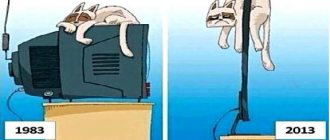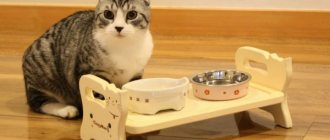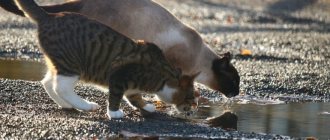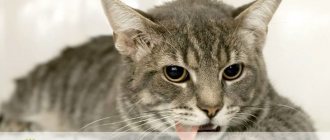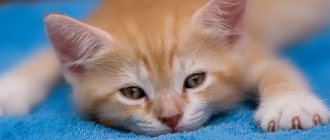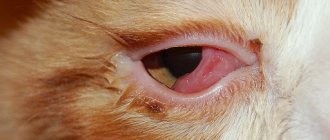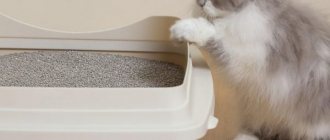Morning or night vomiting in a cat is not that uncommon. If your cat vomits at certain times of the day, you can try to figure out the cause. The first reason is that at the last meal before the cat vomits in the morning or at night, you give him some inappropriate foods. Then you need to analyze them and exclude them from the diet. The second reason is that when too much time passes after eating, the cat experiences hungry vomiting. The third is disruption of the functioning of internal organs. Let's find out in more detail what these conditions are. The famous US veterinarian Karen Baker will talk about this.
This article is part of the information block Vomiting in cats
Possible causes based on the type of vomit
Lack of appetite in pets is common. Often
the health of cats is normalized and does not pose a threat. But there are situations when a minor deviation in a pet’s health develops into a serious pathology. There are several main causes of nausea.
Wool
In the process of washing themselves, cats constantly lick off fur from themselves, which accumulates in their stomach.
Such a lump is called a bezoar. This is a natural and harmless process. By periodically regurgitating hairballs, the pet gets rid of it on its own.
During periods of active molting, bezoars that are too large may form. This is especially true for fluffy long-haired breeds.
The animal cannot vomit such a lump on its own. The most dangerous consequences of this can be blockage of the digestive tract and intoxication of the body.
Poisoning and infections
In the process of washing, cats constantly lick off their fur, which accumulates in their stomach.
Many domestic cats go outside. There they can eat spoiled food or get an infection. Severe poisoning is accompanied by constant vomiting and diarrhea. There is a high probability of dehydration and death.
Infection is accompanied by fever and nausea. It is necessary to quickly determine the type of pathogen and begin treatment. In these cases, contacting a veterinarian is mandatory.
The problem is in the mouth
A common reason for refusing to eat can be oral disease. The most common may be stomatitis, gum disease, and changing teeth.
The cat behaves quite normally during the day; slight anxiety begins only when approaching a cup of food. Therefore, the owner may not notice the problem.
You need to examine the oral cavity and contact a specialist to prescribe treatment.
Intestinal obstruction
The cause of poor health may be intestinal obstruction. It occurs as a result of a foreign body entering the digestive tract. These items could be bones, small toys, Christmas decorations, or overly large hairballs.
Obstruction can also occur due to the development of a hernia, tumor, or intestinal volvulus. Not only does your pet have a lack of interest in food and nausea, he also does not go to the toilet. The condition is very dangerous and without the necessary treatment is fatal.
Be sure to read:
What to do if the kitten cannot poop, how can you tell if the cat is constipated?
Other serious causes of vomiting in cats and kittens
The cause of poor health may be intestinal obstruction.
There are other factors that cause vomiting attacks:
- Worms. After infection with parasites, pets' appetite increases. But pests multiply and occupy large spaces in the stomach and intestines. As a result, the cat begins to refuse to eat food and water, and nausea and diarrhea occur.
- Pathologies of the digestive organs. Cats may also suffer from liver, pancreas or stomach diseases. An accurate diagnosis in this case can only be made by a specialist.
- Pathologies of the urinary system. They develop due to poor quality feed. Males are more often affected. In addition to refusal to eat and vomiting, the animal experiences severe thirst, lack of urination or pain.
- Binge eating. Cats should eat small meals several times a day. Often the owner pours a large bowl of food at once. The stomach cannot cope with digesting large amounts of food and becomes empty.
- Rabies. The disease is often accompanied by refusal to eat and nausea. It can easily be confused with indigestion. But if there is a drooping jaw, excessive drooling and apathy, the pet should be immediately isolated.
How to identify vomiting of bile
The color of bile is believed to be yellow. This is not entirely true - it is yellow-green. This coloring is very intense, so you can determine that a cat is vomiting bile by the color of the vomit. More often they look like mucus or liquid with yellow foam. But there is also vomiting of partially digested food with bile. Then the mass also clearly contains yellow color.
© shutterstock
But a more dangerous sign is the green color of the vomit. It indicates a high concentration of bile in the stomach, and this cannot happen in a healthy animal. To finally make sure that you need to immediately visit a veterinarian, you should take a closer look to see if there are any remains of grass or other vegetation in the masses. Everyone knows that cats eat grass; They often do this to deliberately induce vomiting and clear the stomach of hairballs. They appear there in long-haired animals, as well as during the molting period.
If plant remains are not found or the cat has no chance of eating grass, a veterinarian should be called immediately.
Symptoms signaling disease
Vomiting is a symptom of many pet illnesses . The nature of the masses and their composition differs depending on the type of pathology.
Appearance of white foam
Vomiting is a sign of many diseases in pets.
The appearance of white foam is not always dangerous. This phenomenon is often observed in hungry pets. Long intervals between meals contribute to the fact that the empty stomach begins to produce mucus, which suppresses gastric juice. A mixture of juice, mucus and air forms such foam.
If white foam appears often enough, then there is a high probability of stomach disease.
Vomit with bile
Bile is a yellow-colored impurity in vomit. It causes nausea due to stomach irritation. In isolated cases, the appearance of bile indicates high fat content of food or swallowing large pieces.
Frequent vomiting with bile signals the development of diseases of the liver, pancreas or intestines.
Vomiting food
The appearance of masses of undigested food indicates that the pet is overeating or swallowing too large pieces. The attack appears once.
If this phenomenon is repeated frequently, then there is a likely risk of developing stomach diseases (ulcers, gastritis or colitis). A sick stomach cannot cope with the digestion of food and becomes empty.
Blood impurities
The appearance of blood is a dangerous sign and requires immediate medical attention.
Be sure to read:
A cat has diarrhea and vomiting: what to do at home, reasons, what can be given, what to feed
The appearance of masses of undigested food indicates that the pet is overeating or swallowing too large pieces
In this case, there may be two options:
- Impurities of a bright scarlet hue indicate the presence of open wounds in the oral cavity or esophagus.
- Brown impurities appear when there are wounds in the stomach or intestines.
Factors that cause the appearance of wounds may include the ingress of foreign objects, the development of an ulcer or tumor, liver or intestinal diseases.
When do you need to urgently seek veterinary help?
If you notice that your cat is vomiting bile (concentrated bile mixed with mucus), or there are large blood clots in the mixture, consult your veterinarian immediately. The fact is that such symptoms often indicate volvulus, perforation of a gastric ulcer or a malignant tumor somewhere in the intestines.
Treatment and prevention
If a pet's health worsens, the owner should not treat it themselves. In this case, the risk of complications as a result of incorrectly selected methods and means increases.
An experienced specialist can accurately diagnose and prescribe therapy, taking into account the animal’s condition and the severity of the disease.
Providing first aid to a cat who is vomiting
It is useful for the owner to know what first aid is for a pet.
But any assistance actions can only be carried out under the following conditions:
- the cat looks healthy;
- nausea recurred once;
- there are no additional signs of deterioration in health.
Help may include the following:
- Do not give the animal food or water. Fasting for 24 hours will allow the body to rest and regain strength. To quench your thirst, you can give a piece of ice to lick.
- After a day, you can start feeding him food with a slimy consistency.
- A return to regular food occurs after a couple of days.
- If you suspect poisoning or ingestion of a foreign body, you should induce a vomiting attack. In case of poisoning, such vomiting will only help in the first couple of hours. This will stop the action of toxins, but if a lot of time has passed, they have already entered the bloodstream.
- When worms appear, an antihelminthic drug must be given.
No owner is immune from the deterioration of a pet's condition.
If your health deteriorates significantly, you should immediately contact your veterinarian.
Following simple rules of care will help reduce the likelihood of vomiting attacks:
- feed only fresh food;
- give food in small portions in several doses;
- give preventive vaccinations;
- give antihelminthic drugs annually;
- pets with long hair should be combed with special brushes and given medications to improve the natural elimination of hairballs from the body;
- remove all small objects from reach;
- Periodically visit the veterinarian for a preventive examination.
When medical help is urgently needed
If your health deteriorates significantly, you should immediately contact your veterinarian.
Dangerous symptoms may include the following:
- attacks of nausea continue for several days;
- vomiting appears several times a day;
- foreign impurities appear (bile, foam, blood);
- attacks of nausea appear even between meals;
- there are other symptoms - increased or decreased body temperature, diarrhea, discharge from the nose or eyes, weakness.
Be sure to read:
A cat pees with blood: causes, first aid, how to treat it at home, consequences
The doctor examines the animal and asks the owner about all the details of the deterioration of his health condition. Detailed answers allow the specialist to make a diagnosis and prescribe treatment.
In some cases, additional examinations may be performed - ultrasound, gastroscopy, blood tests or x-rays.
Diseases of the gastrointestinal tract and genitourinary system
Most experts believe that the appearance of nausea in pets, as a rule, is a consequence of improper care and nutrition.
If a pet is diagnosed with gastrointestinal pathologies, diet and medications are used.
Depending on the cause of vomiting, the following may be used:
- rehydration preparations to restore the body’s water balance;
- antiemetics to improve well-being;
- antibiotics to fight bacteria;
- sorbents for cleansing of toxins;
- phytotherapy.
In severe cases, surgery is used. With the help of operations, large bezoars, kidney stones, foreign objects are removed, and large injuries to internal organs are sutured.
Opinion and advice on treating vomiting in a cat from a veterinarian
Most experts believe that nausea in pets is usually a consequence of improper care and nutrition.
If the animal's condition worsens, it is recommended:
- Analyze your diet. Poor or low-quality food in most cases leads to diseases of the gastrointestinal tract. You need to choose the right diet and organize fractional drinking.
- Measure body temperature. In case of infection or inflammation it will rise, in case of poisoning it will decrease.
- Analyze the composition and smell of vomit. This may indicate a possible cause for the worsening condition and may also help your veterinarian make a diagnosis.
- If vomiting occurs in small kittens, you should immediately consult a doctor. Their body is not yet strong, and any deterioration in health can lead to death.
- Do not self-medicate. It may be wrong and have dire consequences.

